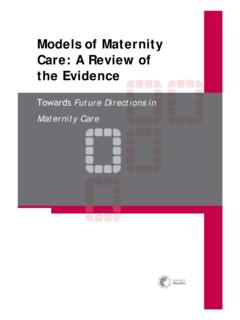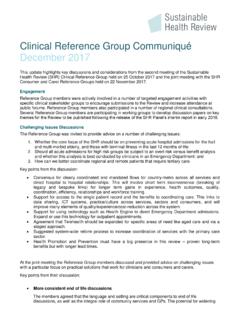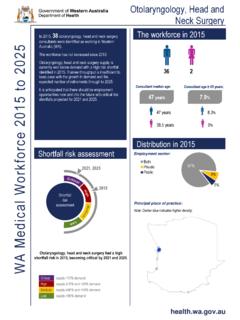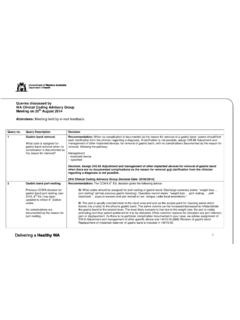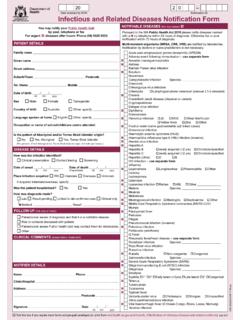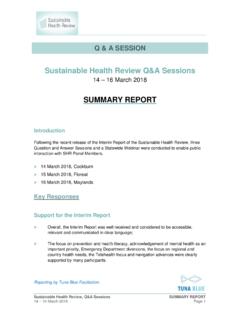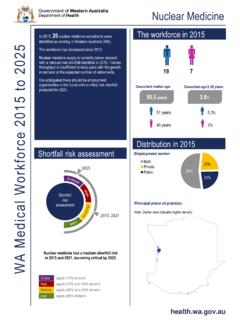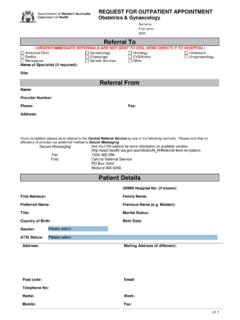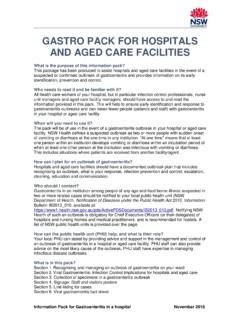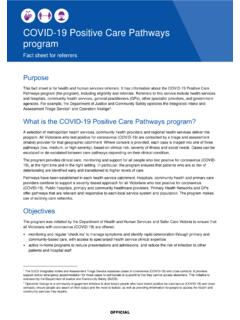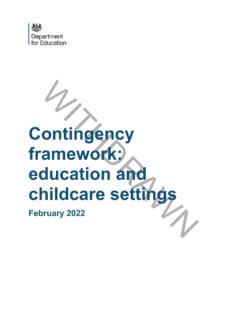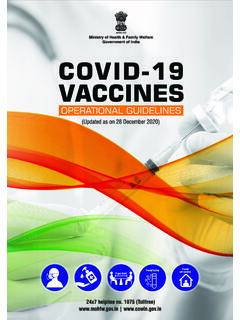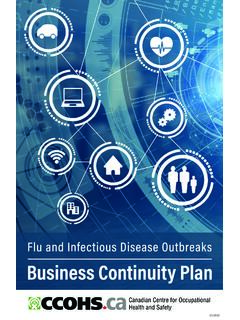Transcription of WA Health WA COVID-19 TTIQ (Test, Trace, Isolate and …
1 WA Health WA COVID-19 TTIQ (Test, Trace, Isolate and Quarantine). Plan Version 11 March 2022. Page 1 of 15. Version Control Version Date Approved by Changes Dr Andrew Robertson, 17 February 2022 Original version Chief Health Officer Added: Very high caseload settings for household close contacts, school and early childhood education settings Dr Andrew Robertson, Links to new WA Health resources and references 11 March 2022. Chief Health Officer to published Directions included throughout Removed: Specific settings for residential aged care facilities, remote Aboriginal communities, critical infrastructure, healthcare workers Page 2 of 15. Table of Contents 4. 1. Purpose and context .. 5. Purpose .. 5. Scope and 5. 2. Principles .. 5. 3. Transition .. 5. 4. Workplace outbreak response .. 6. Responsibilities .. 6. planning .. 6. Response .. 7. 5. Test, Trace, Isolate and Quarantine (TTIQ) in the WA community.
2 8. Definition of a close contact .. 8. Testing, Isolation and 8. Test, Trace, Isolate and Quarantine for specific 11. 6. Resources for high-risk 13. Healthcare facilities .. 13. Residential aged care facilities .. 13. Remote Aboriginal communities .. 13. Congregate living (including mental Health and disability hostels) .. 14. Other settings .. 14. 7. How to escalate when assistance required .. 14. 8. Other key companion documents .. 14. 9. Public information .. 14. Page 3 of 15. Glossary Clearance of a COVID-19 case refers to a COVID-19 case being considered as no longer infectious and able to leave isolation. Refer to Table 1. COVID-19 the disease caused by the virus SARS-CoV-2. COVID-19 case a person who has a positive test for SARS-CoV-2 via PCR or RAT. Contact a person who has been exposed to a COVID-19 case during the case's infectious period. Critical worker for the purposes of the exemption to attend work as an asymptomatic close contact during their isolation period, a critical worker is someone who cannot work from home, and performs work that is: Critical to the COVID-19 response; or Critical to the continuation of critical services that prevent significant harm (including loss of life, catastrophic impacts to safety or welfare or lack of access to essential goods) to any person or the community; or Necessary to the safe continuation of services in an eligible industry; or Requires specialist skills in an eligible industry.
3 For the full list of defined critical workers and for more information, see COVID-19 coronavirus: Critical worker categories ( ). Infectious period the infectious period is considered to commence 48 hours prior to symptom onset, or positive test date if asymptomatic, until the time the COVID-19 case is cleared of infection or can cease isolation, in accordance with the guideline for release from isolation (refer to Table 1). Isolation is the separation from others of a person who is a confirmed or suspected case of COVID-19 . People who have COVID-19 like symptoms and are waiting for test results must also Isolate . Further information is available at HealthyWA. PCR test is the current laboratory-based gold standard diagnostic test for confirming acute active SARS-CoV-2 infection. Public Health refers to the Public Health Operations team within WA Health 's State Health Incident Coordination Centre (SHICC), which undertakes contact tracing activities, and provides advice regarding Test, Trace, Isolate and Quarantine (TTIQ) activities.
4 Quarantine is the separation from others of a person who is well but may have been exposed to COVID-19 . Further information is available at HealthyWA. Rapid antigen test (or RAT) a test that can be used at the point-of- care (by Health professionals) or for self-testing (by a person at home) to detect the presence of viral proteins produced by SARS-CoV-2. Testing by RAT is less sensitive ( less likely to detect the virus in a person with COVID-19 ) than PCR for detecting SARS-CoV-2 but results are available more quickly. SARS-CoV-2 the virus that causes COVID-19 . State Health Incident Coordination Centre (SHICC) refers to the area within WA Health that oversees WA Health 's response to COVID-19 . Trace (or contact tracing) is the process of identifying people who have had close contact with a COVID-19 case during the case's infectious period. For contact tracing purposes, all close contacts should be identified from 48 hours prior to symptom onset or positive test date if asymptomatic, until the person with COVID-19 commences isolation.
5 Workplace refers to a business, facility or service provider. Page 4 of 15. 1. Purpose and context Purpose This Plan provides guidance to businesses, facilities and service providers on preparing for outbreak management as Western Australia (WA) transitions from a low to a very high caseload environment. The trigger point for transition to a high and very high caseload environment is determined by the Chief Health Officer, based on a number of indicators. Given the impact of the Omicron variant of COVID-19 and the lessons and experiences gained from the rest of Australia, there have been significant changes in the approach to management of COVID-19 in the context of widespread community transmission and number of cases. With high vaccination rates in WA at the time of this transition, it is expected that the majority of individuals contracting the infection will have mild symptoms lasting a short number of days, which can be safely managed at home.
6 This document outlines the COVID-19 TTIQ Plan for different settings during this transition. It is a live document that will continue to be updated to reflect policy changes. Scope and context The WA COVID-19 TTIQ Plan (this Plan) acknowledges the maturity of preparation for business continuity and COVID-19 planning that already exists across businesses and government. The anticipated widespread community transmission of COVID-19 with the Omicron variant (and potential future variants) will result in a high number of cases. Noting that the risk of exposure to COVID-19 cannot be eliminated, a risk-managed approach that applies appropriate mitigation strategies will aim to reduce the risk of exposure to COVID-19 . This Plan does not replace local planning or response but is intended to complement existing local, regional and agency-specific plans. It sets out guidance for a risk-based response to COVID-19 .
7 Outbreaks that aims to provide targeted advice, support, care and assistance to those that need it most. All stakeholders should have developed and tested their own COVID-19 response plans, in line with the emergency management principles in which decisions are made at the local level. The State will expect all stakeholders to implement and continuously review their COVID-19 response plans. 2. Principles The general principles of the COVID-19 outbreak response during the transition through two response levels (outlined below) in WA are to: 1. Provide a proportionate, targeted and risk-stratified response to ensure people who are unwell with COVID-19 have access to the appropriate level of care , in the appropriate location. 2. Protect the Health and safety of the general population and workers. 3. Encourage stakeholders to review their business continuity plans and access to surge staff to maintain service delivery.
8 4. Ensure TTIQ measures are provided in a proportionate way. 5. Provide support and advice so that settings can locally manage outbreaks with confidence. 6. Utilise a multi-agency approach, where appropriate, to support a successful response. 7. Ensure all measures are culturally appropriate. 3. Transition In a high and very high COVID-19 caseload environment, Public Health resources are directed to activities with the greatest public Health benefit, such as rapidly identifying and isolating cases. Page 5 of 15. The TTIQ Plan will be actioned at the following response levels (Table 1): 1. High caseload environment response level directed to flattening the infection curve and managing the impact on the WA healthcare system, whilst improving efficiency and focusing contact tracing on areas with the greatest public Health benefit and protecting at- risk populations. 2. Very high caseload environment response level directed to flattening the infection curve and managing the impact on the WA healthcare system whilst permitting essential services to continue operating.
9 The Chief Health Officer determines the point at which WA moves from high to very high caseload environments. 4. Workplace outbreak response Responsibilities Work Health and safety legislation require employers to ensure the safety of workers and others in the workplace, so far as is reasonably practicable. This includes preventing transmission of COVID-19 and responding to cases of COVID-19 in their workplace. The Department of Mines, Industry Regulation and Safety, Safe Work Australia , and the Small Business Development Corporation have further information for industry on their websites. Vaccine mandates for the WA workforce are in place. Employers are responsible for compliance with these, including booster doses. Vaccination (including booster doses) is a crucial part of the COVID-19 response. In both high and very high caseload environments, each workplace is responsible for managing an outbreak in accordance with public Health advice, existing plans, and guidance from relevant overarching organisations or regulators.
10 Workplaces are responsible for implementing, directing, monitoring and overseeing their own outbreak response, with decisions made at local levels. Some high-risk settings may receive additional support from Public Health , where possible, as determined by the Incident Controller and Public Health risk assessment, for example residential aged care facilities (RACFs) and remote Aboriginal communities. This is in addition to support provided through Commonwealth support mechanisms where applicable. planning The State expects workplaces to implement their COVID-19 response plan when there has been a COVID-19 case in the workplace while infectious. Workplaces should implement the following processes: Review and update local COVID plan/business continuity plan, including communications and workforce planning see COVID-19 coronavirus: COVID Safety Plans and Guidelines ( ). Be as prepared as possible to respond to an outbreak with limited additional support.
